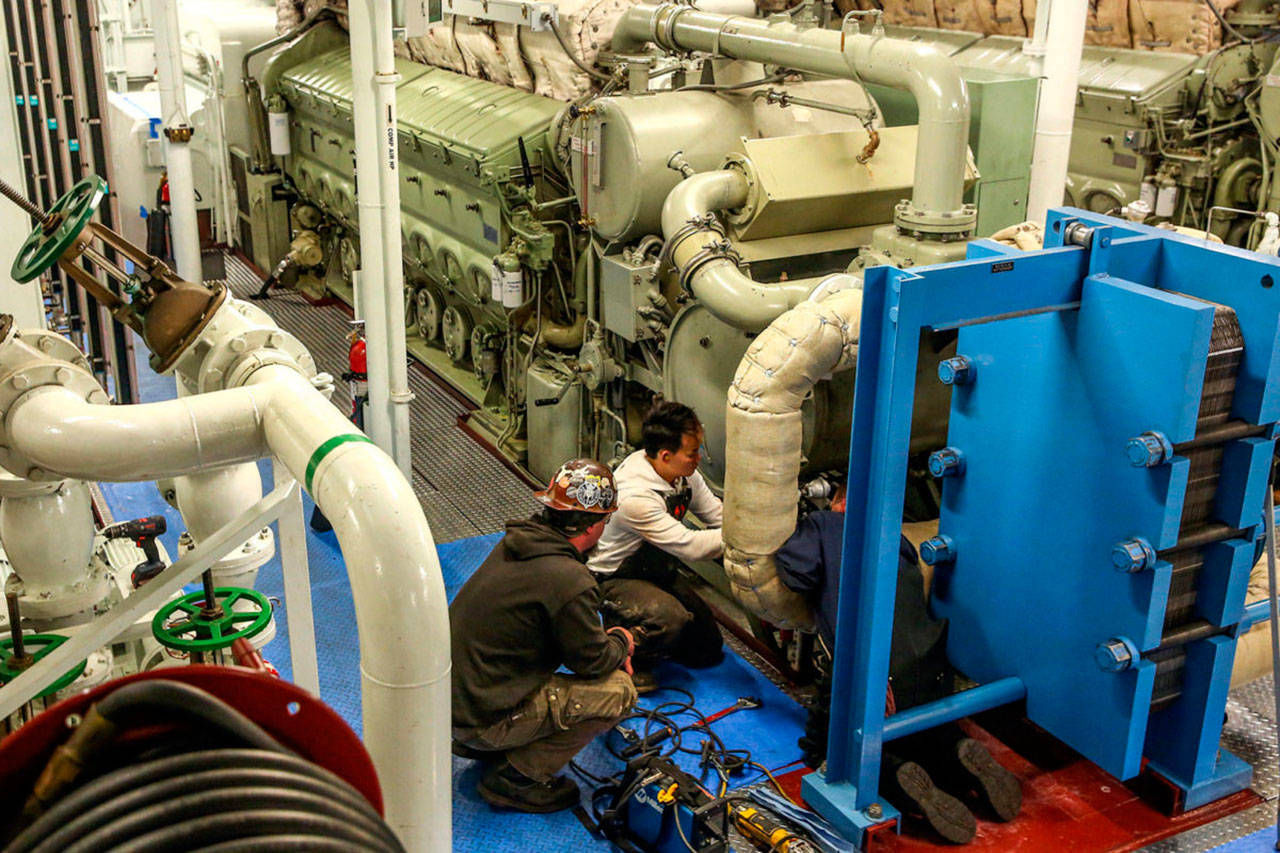As the ferry boat pulls away from the dock, the rumble from the engine grows louder and vibrations rattle passengers on the sun deck.
A quieter, cleaner ride could be on the horizon for people and marine life as Washington State Ferries embarks on an experimental plan to transition the fleet from diesel to electric power.
“It’s new territory, a lot of stuff depends on what we think we can do,” said Mark Nitchman, a chief engineer for state ferries. “But we should espouse what we stand for and lead the way.”
To accomplish this ambitious plan, the agency is starting by converting the three largest ferries in the fleet from diesel to hybrid-electric propulsion. The three Jumbo Mark II boats — the Tacoma, Puyallup and Wenatchee — are the biggest fuel consumers, burning together 14,000 gallons of diesel a day. They usually run on the Seattle-to-Bainbridge and Edmonds-to-Kingston routes.
At the same time, the state has contracted Seattle-based Vigor to build up to five electric-hybrid Olympic class ferry boats, which the state hopes to put into service from 2022 through 2028. They are smaller than the Jumbo Mark II boats and are estimated to cost between $140 million to $180 million per vessel.
This is all part of Gov. Jay Inslee’s goal of moving toward a zero-emissions fleet, which today is the largest consumer of diesel fuel in the state, using over 18 million gallons of diesel a year, according to the state.
Washington State Ferries is leading the way to electric ferries that haul cars and passengers, Nitchman said. And if all goes well, the state could operate the biggest hybrid auto-transporting ferries anywhere in the country.
Replacing the diesel engines in the massive boats with battery packs will be no easy task. Nitchman likens the conversion process to major surgery.
“There’s a lot to learn. We’ve never run a hybrid boat before,” he said. “I’m excited to be diving into this technology.”
Last month, the state selected Siemens, a global company that specializes in power generation, to do the conversion work. Planning work will continue through 2020 with construction likely to begin in 2021.
The plan is to remove two of four diesel engines, which spin a generator to create electricity, and replace them with large battery packs to power the motors. Money from the Volkswagen settlement is paying for a large chunk of converting the first boat, which is estimated to cost about $40 million.
Moving toward this system, boats will not only emit fewer pollutants and consume less fuel but also have fewer parts, saving on labor costs, Nitchman said.
“But there is no free lunch,” he added.
The conversion is the less-complicated portion, said Ian Sterling, a state ferries spokesperson. To be able to run an electric fleet, charging stations have to be designed and built, and the state has to coordinate that work with various utilities providers.
Washington State Ferries set a goal in its 2040 long range plan that in 20 years, 22 of 26 boats in the fleet would be plug-in hybrids and most terminals would have charging stations.
Until the charging infrastructure is installed, the remaining diesel engines will charge the batteries. Only one is needed to do this, so running as a hybrid system will still reduce emissions, according to Nitchman.
Once charging stations are up and running, the agency assumes charging times can be limited to about 20 minutes, the time it takes to offload and onload many boats.
That’s when the real savings will be seen.
“There are savings even before shore charging, just not as much,” Sterling said.
As the big boats are being converted, the state also is building new hybrid boats. They will work much the same way as the converted boats with diesel engines powering the batteries. The diesel engines will then be used as a back-up system.
A lot of the details for both projects are still being worked out.
“It will take a long time to be all-electric, but that’s ultimately where we want to be,” Sterling said.


